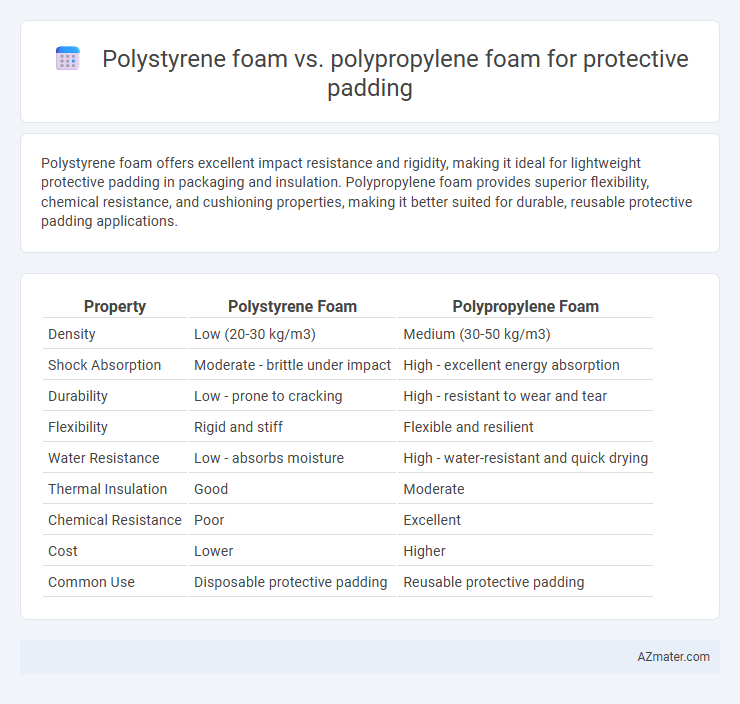Polystyrene foam offers excellent impact resistance and rigidity, making it ideal for lightweight protective padding in packaging and insulation. Polypropylene foam provides superior flexibility, chemical resistance, and cushioning properties, making it better suited for durable, reusable protective padding applications.
Table of Comparison
| Property | Polystyrene Foam | Polypropylene Foam |
|---|---|---|
| Density | Low (20-30 kg/m3) | Medium (30-50 kg/m3) |
| Shock Absorption | Moderate - brittle under impact | High - excellent energy absorption |
| Durability | Low - prone to cracking | High - resistant to wear and tear |
| Flexibility | Rigid and stiff | Flexible and resilient |
| Water Resistance | Low - absorbs moisture | High - water-resistant and quick drying |
| Thermal Insulation | Good | Moderate |
| Chemical Resistance | Poor | Excellent |
| Cost | Lower | Higher |
| Common Use | Disposable protective padding | Reusable protective padding |
Introduction to Protective Padding Materials
Polystyrene foam and polypropylene foam are widely used materials for protective padding, each offering distinct benefits in impact absorption and durability. Polystyrene foam provides excellent shock resistance and lightweight cushioning, making it ideal for packaging fragile items and protective gear. Polypropylene foam delivers superior flexibility, resilience, and moisture resistance, which enhances comfort and long-term performance in protective padding applications.
Overview of Polystyrene Foam
Polystyrene foam is a lightweight, rigid material commonly used in protective padding due to its high impact resistance and excellent cushioning properties. Its closed-cell structure provides superior shock absorption and moisture resistance, making it ideal for packaging delicate electronics or fragile items. Compared to polypropylene foam, polystyrene foam offers better compression strength but is less flexible and less resistant to repeated impacts.
Overview of Polypropylene Foam
Polypropylene foam offers a lightweight, durable, and highly resilient material ideal for protective padding, featuring excellent impact absorption and resistance to moisture and chemicals. Unlike polystyrene foam, polypropylene foam combines flexibility with strong cushioning properties, making it suitable for various packaging and protective applications. Its closed-cell structure enhances insulation and durability, providing superior long-term performance in demanding environments.
Physical Properties Comparison
Polystyrene foam offers high rigidity and excellent impact absorption due to its closed-cell structure, making it ideal for protective padding that requires firm cushioning. Polypropylene foam, characterized by its lightweight, flexibility, and superior resistance to fatigue and moisture, provides enhanced durability and comfort in protective applications. The density of polystyrene foam typically ranges from 20 to 100 kg/m3, whereas polypropylene foam varies between 30 and 150 kg/m3, influencing their compressive strength and energy absorption capacities in protective padding.
Impact Resistance and Shock Absorption
Polystyrene foam offers excellent impact resistance due to its rigid cellular structure, making it ideal for protecting against sudden shocks and compressive forces in protective padding applications. Polypropylene foam provides superior shock absorption through its flexible and durable material, effectively dispersing energy from impacts and reducing pressure on the body. Choosing between the two depends on the specific protective needs, with polystyrene excelling in high-impact resistance and polypropylene offering enhanced cushioning and comfort.
Weight and Density Differences
Polystyrene foam typically exhibits a higher density range of 20-40 kg/m3 compared to polypropylene foam's lower density, usually between 10-30 kg/m3, making polypropylene foam significantly lighter in protective padding applications. The weight advantage of polypropylene foam enhances portability and comfort while maintaining adequate impact absorption. Polystyrene's greater density contributes to superior rigidity and cushioning, but at the cost of increased weight, influencing material choice based on specific protective padding requirements.
Durability and Longevity
Polystyrene foam offers excellent impact absorption but tends to degrade faster under prolonged stress and exposure to moisture, reducing its overall durability and longevity. Polypropylene foam demonstrates superior resilience against wear, chemical exposure, and repeated compression, making it more durable and longer-lasting for protective padding applications. This enhanced durability positions polypropylene foam as the preferred choice for high-performance and long-term protective solutions.
Environmental Sustainability and Recycling
Polystyrene foam, commonly used in protective padding, poses significant environmental challenges due to its non-biodegradable nature and limited recycling options, often ending up in landfills or oceans. Polypropylene foam offers a more sustainable alternative with better recyclability and lower environmental impact, as it can be efficiently reprocessed and reused in various applications. Choosing polypropylene foam for protective padding supports circular economy efforts and reduces the ecological footprint compared to traditional polystyrene materials.
Cost and Availability Factors
Polystyrene foam offers a lower cost and wide availability, making it a popular choice for protective padding in various industries. Polypropylene foam, while slightly more expensive, provides enhanced durability and greater chemical resistance, which can justify the investment for specialized applications. Supply chains for polystyrene foam are well-established globally, whereas polypropylene foam availability may vary depending on regional manufacturing capabilities and demand.
Best Use Cases for Each Material
Polystyrene foam excels in protective padding for fragile items like electronics and packaging due to its high rigidity and excellent impact absorption, making it ideal for shipping and insulation. Polypropylene foam offers superior flexibility and durability, which suits applications needing repeated cushioning and resistance to wear, such as sports equipment padding and automotive interiors. Choosing between the two depends on the specific impact resistance, weight, and reusability required in the protective padding application.

Infographic: Polystyrene foam vs Polypropylene foam for Protective padding
 azmater.com
azmater.com